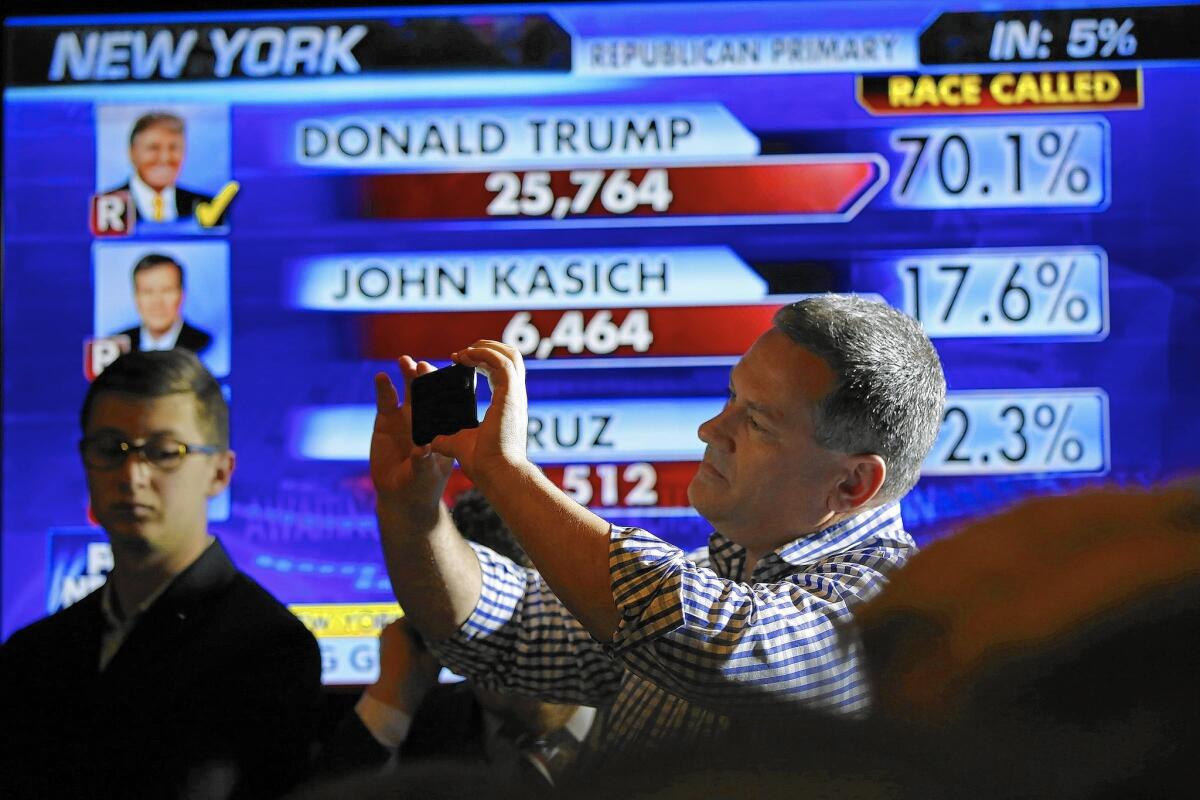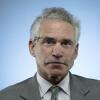Road to GOP nomination looks smoother for Trump, but there are bumps ahead

Results from the Republican primary in New York.
Widening his delegate lead, Donald Trump has taken a significant stride toward clinching the Republican presidential nomination and avoiding a knockdown fight at the party’s summer convention. But the contest is far from settled.
Trump’s landslide win in Tuesday’s New York primary snagged him at least 89 delegates, pushing his total to 845 of the 1,237 needed to secure the GOP nomination. His nearest rival, Texas Sen. Ted Cruz, was shut out and trails the Manhattan real estate mogul by nearly 300 delegates.
With seven weeks left in the primary season, Trump must capture about 55% to 60% of the remaining delegates for a first-ballot victory at the convention in Cleveland — a formidable but not impossible task.
The Republican front-runner is likely to substantially add to his delegate total next week, when five politically friendly states hold their primaries. He stands a good chance to win them all and most of the 172 delegates at stake.
But after Tuesday, a major test looms May 3 in Indiana, the closest thing left on the primary calendar to a pure toss-up. Even if Trump does well there, he will still need a strong performance in California on June 7, the final day of the Republican primary season, to win the nomination before delegates gather in Cleveland six weeks later.
“That will be the sort of Waterloo,” said Katie Packer, the head of Our Principles political action committee, a group funded by major Republican donors that has spent heavily on advertising to keep Trump from capturing the nomination. “Either he wins or he loses — it’s going to happen there.”
Trump has retooled his campaign and become a more restrained, better disciplined candidate of late. But the political map and mathematics of delegation selection will dictate his fate as much or more than any personnel move or personality makeover.
The next several states to vote, on April 26 — Connecticut, Delaware, Maryland, Pennsylvania and Rhode Island — line up well for Trump. They are urban, largely secular and lean Democratic.
Republicans, as members of the minority party, “often feel oppressed by the Democratic regime that runs their states and the White House, and that feeds into a sense of alienation that Trump has capitalized on,” said David Wasserman of the Cook Political Report, who has closely studied the demographic patterns of the presidential race. “You could expect him to do very, very well.”
Other states stack up better for Cruz, including Nebraska on May 10 and Montana on June 7, which, combined, offer 63 delegates. Trump has not done especially well in the country’s midsection or less urbanized portions of the West.
------------
FOR THE RECORD
April 21, 8:49 a.m.: An earlier version of this article stated that there are 91 Republican convention delegates at stake in Nebraska and Montana combined. The two states have a total of 63 delegates.
------------
Indiana, with 57 delegates, is a state where Trump and Cruz both start out competitive.
It has a significant number of Christian conservative voters and well-educated suburbanites; the latter helped drive Cruz’s landslide victory this month in Wisconsin. There is also a large number of working-class voters who have suffered from Indiana’s manufacturing decline; victims of such economic upheaval are a big portion of Trump’s base.
Even Ohio Gov. John Kasich, largely an afterthought in the race, could do well in pockets of Indiana that touch upon his home state of Ohio. Kasich picked up a handful of delegates in New York.
In an unusual plea for intervention, his chief strategist, John Weaver, issued a memo Wednesday laying out a state-by-state strategy for anti-Trump forces to attack the businessman in next Tuesday’s contests. Several well-funded groups that pounded Trump in earlier states, with mixed results, sat out New York, and Weaver said that contributed to Trump’s overwhelming success.
Failure to engage “on April 26 would put Donald Trump on track to win the nomination on the first ballot,” Weaver warned.
Packer said the anti-Trump group she leads was deciding whether to target some congressional districts in Maryland and would make a more substantial investment in Indiana.
But nothing will be settled until the GOP contest comes to California, which offers 172 delegates — by far the most of any state.
California Republicans have a long history of staunch opposition to illegal immigration, an important edge for Trump.
But Cruz’s alignment with the religious right also makes him a comfortable fit, especially in the agricultural heartland of the Central Valley.
As in New York, Kasich stands at least an outside chance of gaining a few delegates in the more prosperous, better-educated coastal regions where many Republicans prefer party establishment types.
Still, the arcane rules governing the high-stakes delegate fight mean this will not be a typical California campaign with costly TV advertising driving the result.
Instead, organizational muscle will be crucial. Cruz has taken advantage of Trump’s inexperienced campaign to outhustle the neophyte candidate in a number of states choosing their representatives to the national convention.
Apart from vigorously crying foul, Trump has responded by shuffling his team, hiring several more experienced political insiders to oversee the delegate-wrangling process.
The question, though, is whether the change comes too late; Trump is also in danger of being outmaneuvered in California, where his lead in the polls won’t necessarily translate into the kind of delegate landslide he pulled off in his home state.
Under party rules, it’s a winner-take-all contest in each of California’s 53 congressional districts, with three delegates up for grabs in each. Another 13 delegates go to the statewide winner.
First, though, each candidate has until May 8 to submit a slate of 169 delegates; the remaining three are party leaders. The candidates must be careful, though, to find loyalists who won’t abandon them if multiple votes take place at the national convention. In other states, many Trump delegates plan to switch to Cruz if they get the chance.
To find three staunch supporters in every California congressional district, along with three alternates, is no easy task.
“It’s a daunting logistical and organizational challenge,” said Jeff Randle, a GOP operative in Sacramento who rounded up California delegates for Mitt Romney in 2012.
The Cruz campaign has a huge head start. Led by former chairmen of the state GOP, the Cruz team has been building its delegate slate and plotting a district-by-district strategy since last August. The Trump campaign only hired its state director last week.
Josh Putnam, a University of Georgia expert on the delegate selection process, has been carefully tracking the nominating fight and charting the progress after every contest.
“Either way you slice it,” he said, “it looks like this thing is going to be really close.”
Twitter: @markzbarabak
Twitter: @finneganLAT
Barabak reported from New York and Finnegan from Los Angeles.
More to Read
Get the L.A. Times Politics newsletter
Deeply reported insights into legislation, politics and policy from Sacramento, Washington and beyond. In your inbox three times per week.
You may occasionally receive promotional content from the Los Angeles Times.








